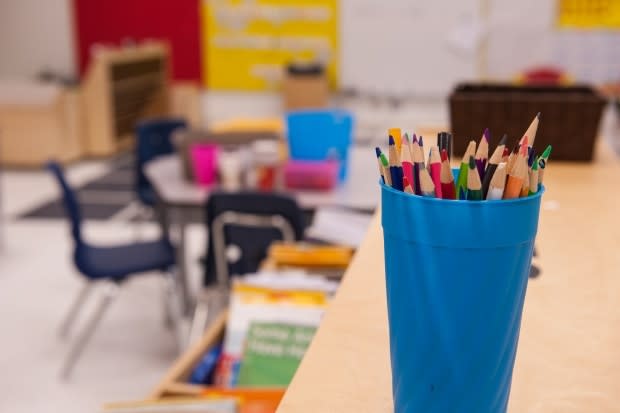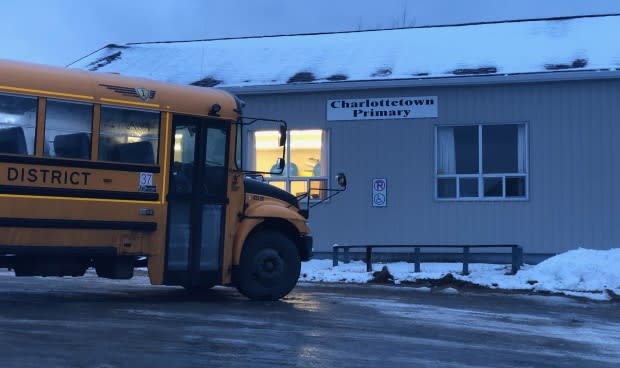Nothing set in stone as NLESD reviews schools for closure
Amy Hayley of Charlottetown, N.L., can understand why her youngest daughter's school is slated for potential closure next year — right now it has only three students — but says the news is heartbreaking all the same.
Hayley's daughter attends kindergarten at Charlottetown Primary, and if the school closes, she will have to bus from their town to Glovertown beginning in September 2020.
"To close a chapter like that in our community is heartbreaking to me," Hayley said. Her three older children went to Charlottetown Primary as well, and the school holds a lot of memories for her and others in the community.
The Newfoundland and Labrador English School District has five schools potentially up for closure at the end of the school year, but said public consultation needs to be done and nothing has been decided yet.

At its public meeting over the weekend, the district issued notices of motion to close five schools as of June 2020. Those schools are:
St. Thomas Aquinas, K-8 (Port au Port).
Stephenville Elementary, 4-5.
Charlottetown Primary, K-3.
Sandstone Academy, K-6 (Ladle Cove).
Pearce Junior High, 8-9 (Burin Bay Arm).
Tony Stack, CEO of the school district, said nothing has been officially decided.
"Where the notice of motion includes even the possibility of a school closure, there has to be further consultation, which includes a public meeting in which members of the board would hear directly from the public based on the proposed motion," said Stack.
The school board is working to put together all available information online ahead of a public meeting, to be scheduled in either late January or early February.
Concerns about bus trip, parent involvement
Hayley said she can see some of the arguments for closing the school in Charlottetown. While her daughter gets along well with the other two current students in Charlottetown, she will meet more children in a larger school, she said, which may have social benefits.
However, she said she has concerns about adding a bus trip of 35 kilometres to the day for a child as young as hers. The move also makes it harder for parents and families to participate in the school community, she said, and for children to have extracurricular activities after school.
"It's hard for our kids to be involved in the community in Glovertown when they're part of the community here in Charlottetown," Hayley said.
Stack said he understands why there is always opposition to the potential closing of a school.
You've got small numbers in each grade level and there's a social and emotional learning benefit to being with alike age groups. - Tony Stack
"Schools are communities; they're much more than bricks and mortar. There's human beings in there," Stack said.
"Obviously there's a lot of emotion attached to a school community and there will be some people that will be opposed, certainly."
Concerned parents
Two parents from two different regions of Newfoundland spoke out against the NLESD's decisions.
Ruby Hoskins of Marystown said parents in her area met with the school board with a full hopper of questions and concerns recently, but not many of their questions were actually met with answers.
"A lot of parents are still demanding answers right now, because there's too much upheaval to be caused by the reconfiguration of the entire school system in the Marystown-Burin area," Hoskins told CBC Radio's On The Go.
Hoskins said there will be an additional strain on the high school in her area as about 220 students will be added to the enrolment list.
She's worried class sizes will become far too big.
"It's just a physical improbability to put another 220 students in that school and not have scheduling issues," she said.
Jan Crane in Port au Port said parents in her area are facing similar issues if schools become restructured in her area.
Crane added that the school system in her community is already doing a good job at educating the area's youth. She feels it's actually exceeding other area's of the province.
However, she said the NLESD hasn't been able to tell parents in her community just how it plans to make programming better for students if it's already doing a perceivably good job in Port au Port.
"What is the board's real agenda behind this? As of this morning ... they said again that this was not a financial decision," she said.
"So if its not programming ... they have to let us know why the move is being made."
More sustainable programming
Stack said while any talk of closing a school can prompt an automatic response, the purpose of reviewing these school systems is to ensure services are being delivered in the best way possible, to ensure education is the best it can be.
Sandstone Academy's closure would mean the K-6 students would join those in grades 7-12 who are already bused to Phoenix Academy in Carmanville.

"One of the reasons why this one was looked at was, you've got small numbers in each grade level and there's a social and emotional learning benefit to being with alike age groups," Stack said.
"And there are some programming advantages and synergies around grouping staffing together."
In the Marystown region, the motion to close Pearce Junior High is part of a larger, two-motion plan to streamline where students in the region attend school.
Under the first motion, Marystown Central High, which currently has Grade 10-12 students, would take all of the area's 8-12 students, starting September 2020.
The second motion would see the reconfiguration of Sacred Heart Academy in Marystown from a K-7 to a K-4 school; Donald C. Jamieson in Burin Bay Arm would change from a K-7 to a 5-7 school.
"When we went around and consulted, initially we were looking just at the 8-12 factor, but in part of the feedback in consultation we heard there's some advantages to combining the grades," Stack said.
"You might have a more sustainable French immersion program, for example, if you had all the students in the area flow together through the same grade in the same school, so we put that in as an option."
Reconfiguring school resources is a familiar struggle for a province with a declining student population.
"Decades ago there was 160,000 students in the system. We're down now to under 65,000, so over the years it's been a very stark, sharp dropoff," said Stack, who added the Avalon area is one of the few regions where the student population is not declining.
Read more from CBC Newfoundland and Labrador

